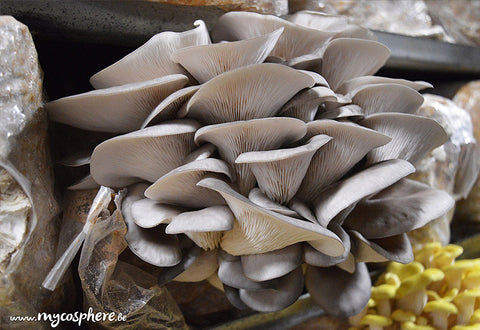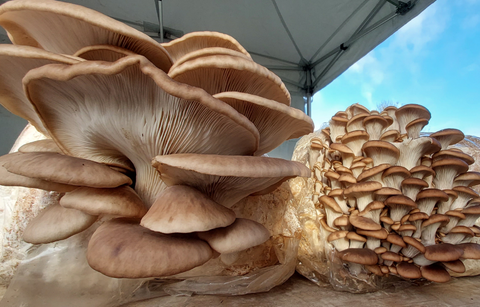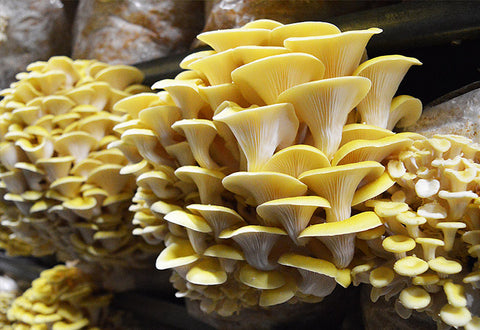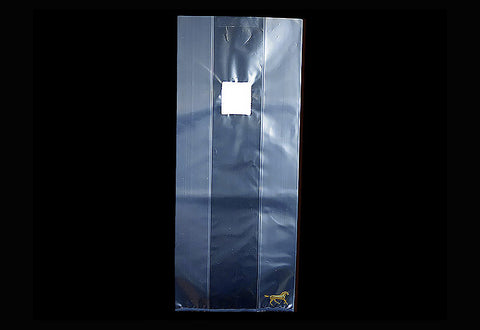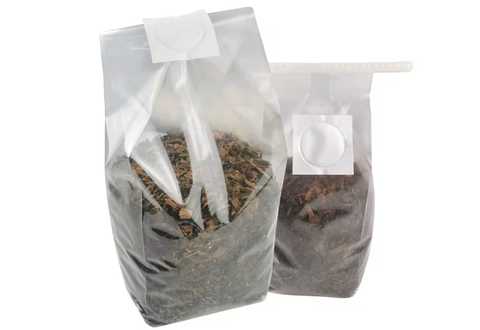
Ecological and innovative materials, mycomaterials have multiple potentials: thermal and acoustic insulation, packaging, bioremediation and filtration, design, etc.
Mycomaterials are materials composed of raw materials that have been transformed and fused with mushroom mycelium.
The applications of mycomaterials are varied, mainly divided into three major families:
- Insulating Panels: Offer excellent acoustic and thermal insulation, ideal for applications in construction and architecture.
- Objects and Packaging: These innovative forms can replace polystyrene in packaging, offering a biodegradable and ecological alternative.
- Fungal Leathers: A sustainable alternative to animal-origin leathers, suitable for fashion and leather goods.
Physical Characteristics
Mycomaterials are distinguished by their unique appearance and texture:
- Visual Aspect: Generally white in color, with a smooth surface.
- Texture: A soft and fluffy touch, reminiscent of the softness of certain fabrics.
- Renewable Resources: Made from renewable resources, unlike materials derived from the petrochemical industry.
- Less Energy and Emissions: Production generally requires less energy and generates fewer greenhouse gas emissions.
- Biodegradability: 100% biodegradable, naturally decomposing without leaving toxic waste, ideal for packaging replacing single-use plastics.
- Compostability: Can be composted, reintegrating into the natural nutrient cycle.
- Thermal and Acoustic Insulation: Interesting properties for manufacturing insulating panels, helping to reduce energy consumption in buildings.
- Natural Resistance: The mycelium makes substrates naturally resistant to water and fire.
- Insulation Panels
-
Eco-Friendly Packaging
Mycelium is used to create biodegradable alternatives to polystyrene and other synthetic packaging materials. These packages can be designed to protect various products during transport, and they naturally decompose after use.
-
Plant-Based Leather
Mycelium can be cultivated and processed to create a material similar to leather, often called fungal leather. This plant-based leather is used in fashion and leather goods, offering a sustainable and ethical alternative to animal leather.
-
Furniture and Decoration
Chairs, tables, and other interior decoration elements can be made from mycomaterials, offering unique design and a reduced ecological footprint.
-
Electronics and Car Components
Mycomaterials are also being explored in the electronics and automotive sectors for the manufacture of lightweight and durable components.
-
Textiles and Clothing
Some projects are experimenting with mycomaterials to create innovative textiles, offering an alternative to synthetic fabrics.
These panels are used in construction for thermal and acoustic insulation. They are lightweight, durable, and offer good insulation, while being fully biodegradable.
How to produce mycomaterials?

The different stages The production of mycomaterials is similar to the first part of the classic mushroom production:
- The choice of substrate and variety
- pasteurization
- inoculation
- incubation
- molding
- drying
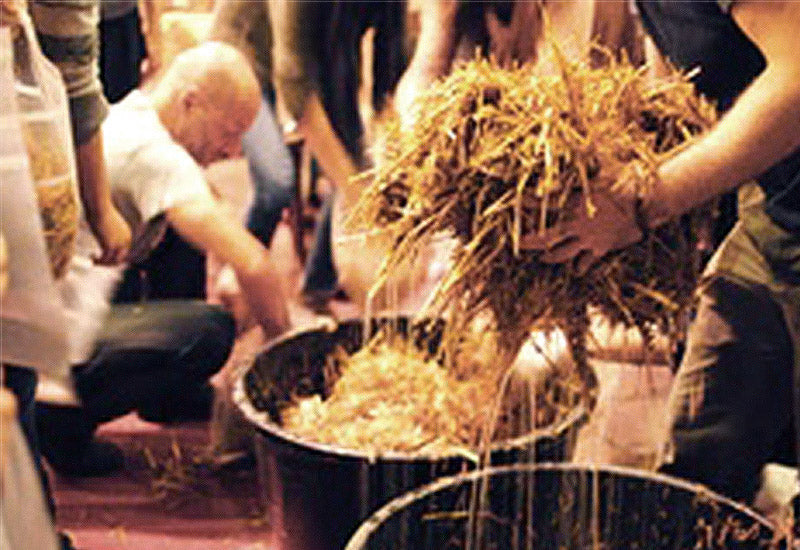
1) The choice of substrate and variety
There is a multitude of different substrates that can be used: cereal straw, hemp fibers, wood chips, sawdust, cardboard, residues from the agri-food industries, various textiles, coconut husk, etc.
Given the ecological approach that often accompanies projects around myco-materials, the substrates generally chosen also aim to repurpose waste from other activities and to valorize local materials to reduce transportation and carbon impact.
Beyond these ecological considerations, there are also technical aspects to take into account to ultimately obtain a good quality product:
The varieties used for biomaterials are fungi lignivores & saprophytes : they naturally degrade dead wood and more generally carbonaceous materials.
A substrate too rich in nitrogen or sugar will be more favorable to bacteria, and you will therefore have to “fight” harder with more energy focused on sterilizing the substrate and maintaining sterility during inoculation and incubation processes.
Conversely, a highly carbonaceous substrate is called “selective” because few other microorganisms besides fungi can develop on wood chips.
However, a lack of nitrogen and sugars can result in a weak mycelium, too slow and possibly incomplete colonization of the substrate, and therefore a lower quality yield.
➡️ Our advice : A carbon-based substrate such as straw or sawdust/wood chips (preferably hardwood) is generally used at 80-90%, enriched with a richer material like cereals, coffee grounds, hay, or other at 10-20%.
Mycelium is a living organism that needs oxygen to live, to colonize, and to decompose its substrates.
A substrate that is too dense or waterlogged will not allow it to breathe sufficiently and will then be more conducive to anaerobic bacteria, for example. A substrate that is too dry will result in poor colonization of the substrate.
➡️ Our advice : A rate ranging from 60% humidity is recommended for a sawdust-based substrate to 70% for straw-based substrates.
Depending on the intended use, the materials will require more or less rigidity. For insulating panels, for example, a fibrous texture is preferred.
The choice of mycelium is of course important because some are stronger than others. The mycelium acts as a binder, like a glue that holds all the materials together. What provides the strength are the fibers (chopped cereal straw, plant stems, jute fabrics, etc.).
Just like in building construction, we "reinforce" the concrete: we add metal structures into the concrete to give it better strength and durability.
The fibers will also aerate the substrate, thereby improving its insulating properties. However, fibers that are too long will not be practical to use because they won't fit well into molds, may puncture the bags, and will over-aerate the substrate.
➡️ Our advice: Use a mix of chopped straw (ideally 1-3 cm) with 10 to 20% wood sawdust (our optimal substrate works very well).

The choice of the variety :
- reishi (ganoderma lucidum)
- turkey tail (trametes versicolor)
- oyster mushroom (pleurotus ostreatus)
The reishi and the tramete are part of the “polypore” mushroom family: these are naturally very rigid mushrooms that you can find on tree trunks (living or dead). These mycelia are very “aggressive,” meaning they are quick to colonize a substrate and have a good ability to react to other competing microorganisms. By playing with maturation times, these mycelia will also produce different colorations.
The reishi mycelium can develop yellow, orange, and red colors. The tramete mycelium tends toward beige and dark brown colors.

Above, a reishi block at the beginning of fruiting
The mycelium of oyster mushroom is also regularly used. Like the previous 2 mycelia, it is fast and adapts to a multitude of different substrates. It is a bit less solid and dense than the polypores, but it is one of the most widespread mycelia due to the cultivation of oyster mushrooms for food.
The yellow oyster mushroom and the pink oyster mushroom can also be used for the colorations visible on their mycelium, which can give interesting results from an artistic point of view. However, the pink oyster mycelium has a more fragile texture.
2) Pasteurization or sterilization
This step aims to eliminate the majority or all of the microorganisms originally present in the substrate to give free rein to the chosen mycelium.
Insufficient pasteurization will generally result in “contaminations”: typically, these will be bacteria or molds that will colonize all or part of the substrate, resulting in a significantly lower quality than expected, or even completely unusable depending on the case.
There are different ways to pasteurize or sterilize a substrate, but this is not the subject of this article. To start, we recommend the 2 simple methods of pasteurization with lime or heat.

3) Inoculation, or the seeding of the substrate
Après la pasteurisation et le refroidissement à une température inférieure à 40°C., le substrat va être mélangé avec le mycélium. On utilise généralement du mycélium sur grain because it allows good dissemination of the mycelium in the substrate, as well as providing energy for the mycelium and therefore faster colonization.
The inoculation rate can vary depending on the substrates used and the sterility level of the techniques. Under optimal laboratory conditions, 1 to 2% mycelium is used.
For a poor substrate (= richer in carbon) and non-sterile inoculation conditions, between 5 and 10% grain spawn mycelium is used. A higher inoculation rate allows faster colonization and thus reduces the risk of failure due to contamination by other microorganisms.
Containers:
Substrates are generally placed in perforated plastic bags or equipped with filters (our unicorn bags, plastic sleeves, or buckets). The use of plastic at this stage serves several functions: containing the substrate, maintaining a constant humidity level, preventing contaminants (microorganisms and insects) from entering the substrate. Professional bags are equipped with a microfilter that allows oxygen intake while preventing the entry of bacterial or mold spores.
On a small scale, and to reduce the carbon impact, it is possible to use reusable containers. However, note that these must be thoroughly cleaned to avoid recontaminating the substrates after pasteurization, and they must also allow the mycelium to breathe (for example, a bucket with a cotton plug).
4) Incubation
This is the phase where the mycelium will colonize its substrate and digest it. For this step, the mycelium needs warmth: an ideal temperature between 20 to 25°C. Light has little impact at this stage, but it is generally recommended to place the substrates in the dark. As soon as the substrate is colonized, you can move on to the next step.

5) The molding
After the substrate is fully colonized by the mycelium, it is placed in its mold, which will give it the desired shape. The substrate is broken up, crumbled, and evenly distributed. Depending on the projects and goals, molds can be made, for example, with a 3D printer, or for hobbyists using recycled objects (vases, bottles, etc.). Although the substrate is already colonized by the mycelium, it is important to work cleanly and disinfect everything that comes into contact with the mycelium.
After molding, the substrate is incubated again for 3 to 7 days to allow the mycelium fragments to fuse and improve strength. During this phase, the mycelium still needs oxygen and constant humidity. Depending on the mold size, it may sometimes be necessary to pierce them for better air supply.
It is also possible to incubate the mycelium directly in its final mold after inoculation. However, it should be noted that crumbling and fragmenting the mycelium after substrate colonization generally results in better strength afterward.
Results may vary depending on the materials, variety, temperatures, humidity levels in the air and substrate, incubation duration, etc. Mushrooms are very responsive to their environment. It's up to you to experiment to better understand how mycelium works and find the processes that best suit your needs.

6) Drying
When the result is achieved, drying is done to stop the mycelium activity and thus prevent it from continuing the degradation of the substrate and entering fruiting. Drying can be done at low or high temperature. It is important to note that the mycelium tends to retain moisture, which prolongs the drying time. Even if the outside seems dry, the inside of the object may remain moist, favoring the appearance of small molds.
On a small scale, it is possible to dry them outside on beautiful sunny days or in the oven. In the oven, you can use fan heat with a temperature preferably below 80°C. Alternate 1 hour of heating, 1 hour of rest, regularly opening the oven door to release moisture. The total duration, depending on various factors, generally ranges between 6 and 48 hours.
At a professional scale, the use of specific dehydrator ovens is recommended. It is essential to have temperature control and air renewal for uniform and sufficiently fast drying, ensuring a good quality result.
We offer you 2 options:
-
Easy Level:
Our ready-to-fruit reishi grow blocks. You just have to crumble it finely, put it in the mold of your choice, then dry it after colonization. -
Intermediate level:
- We recommend the reishi grain spawn.
- Use our microfilter bags for incubation.
- And our straw pellets as substrate.
- Follow the previously mentioned steps.

It’s also a great activity to do with children. Success is guaranteed. It’s a great way for them to get in touch with the mycelium and the mysterious kingdom of mushrooms. From there, you can discuss with them how they work, how they feed, their modes of reproduction. And it’s also an opportunity to address topics on ecology and the economy of natural resources.
You can also choose our DIY Pack with everything you need inside.
To go further:
- Growing Gourmet & Medicinal Mushrooms, Paul Stamets.
- Mycelium Running, Paul Stamets.
- Radical Mycology, Peter Mc Coy
- Compressive behaviour of anisotropic mycelium-based composites (Rigobello & Ayres 2022).








